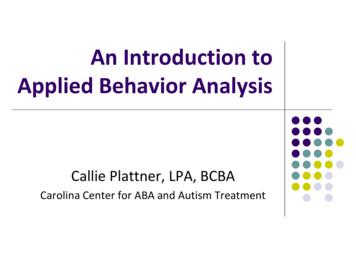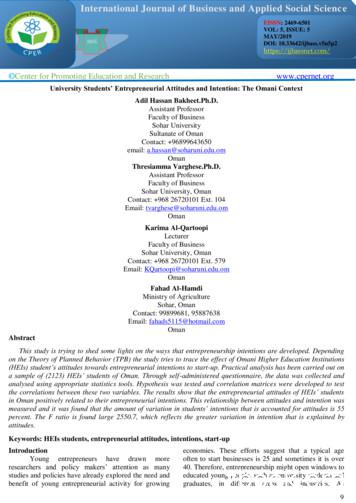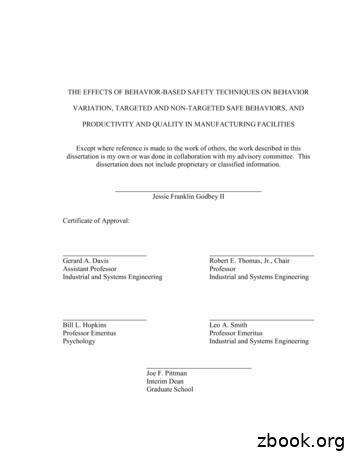HEALTH BEHAVIOR - Masaryk University
Glanz.ffirs7/2/0811:22 AMPage iiiHEALTHBEHAVIORANDHEALTHEDUCATIONTheory, Research,and Practice4TH EDITIONKAREN GLANZBARBARA K. RIMERK. VISWANATHEditorsForeword by C. Tracy Orleans
Glanz.ffirs7/2/0811:22 AMPage ii
Glanz.ffirs7/2/0811:22 AMPage iHEALTHBEHAVIORANDHEALTHEDUCATION
Glanz.ffirs7/2/0811:22 AMPage ii
Glanz.ffirs7/2/0811:22 AMPage iiiHEALTHBEHAVIORANDHEALTHEDUCATIONTheory, Research,and Practice4TH EDITIONKAREN GLANZBARBARA K. RIMERK. VISWANATHEditorsForeword by C. Tracy Orleans
Glanz.ffirs7/2/0811:22 AMPage ivCopyright 2008 by John Wiley & Sons, Inc. All rights reserved.Published by Jossey-BassA Wiley Imprint989 Market Street, San Francisco, CA 94103-1741—www.josseybass.comNo part of this publication may be reproduced, stored in a retrieval system, or transmitted in any formor by any means, electronic, mechanical, photocopying, recording, scanning, or otherwise, except aspermitted under Section 107 or 108 of the 1976 United States Copyright Act, without either the priorwritten permission of the publisher, or authorization through payment of the appropriate per-copy feeto the Copyright Clearance Center, Inc., 222 Rosewood Drive, Danvers, MA 01923, 978-750-8400,fax 978-646-8600, or on the Web at www.copyright.com. Requests to the publisher for permissionshould be addressed to the Permissions Department, John Wiley & Sons, Inc., 111 River Street,Hoboken, NJ 07030, 201-748-6011, fax 201-748-6008, or online at www. wiley.com/go/permissions.Readers should be aware that Internet Web sites offered as citations and/or sources for further information may have changed or disappeared between the time this was written and when it is read. Limitof Liability/Disclaimer of Warranty: While the publisher and author have used their best efforts inpreparing this book, they make no representations or warranties with respect to the accuracy or completeness of the contents of this book and specifi cally disclaim any implied warranties of merchantability or fi tness for a particular purpose. No warranty may be created or extended by sales representatives or written sales materials. The advice and strategies contained herein may not be suitable foryour situation. You should consult with a professional where appropriate. Neither the publisher norauthor shall be liable for any loss of profi t or any other commercial damages, including but not limitedto special, incidental, consequential, or other damages.Jossey-Bass books and products are available through most bookstores. To contact Jossey-Bassdirectly call our Customer Care Department within the U.S. at 800-956-7739, outside the U.S. at317-572-3986, or fax 317-572-4002. Jossey-Bass also publishes its books in a variety of electronicformats. Some content that appears in print may not be available in electronic books.Library of Congress Cataloging-in-Publication DataHealth behavior and health education : theory, research, and practice / Karen Glanz, Barbara K.Rimer, and K. Viswanath, editors. — 4th ed.p. ; cm.Includes bibliographical references and index.ISBN 978-0-7879-9614-7 (cloth)1. Health behavior. 2. Health education. 3. Health promotion. I. Glanz, Karen. II. Rimer, Barbara K.III. Viswanath, K. (Kasisomayajula)[DNLM: 1. Health Behavior. 2. Health Education. W 85 H43415 2008]RA776.9.H434 2008613—dc222008021038Printed in the United States of AmericaFOURTH EDITIONHB Printing 10 9 8 7 6 5 4 3 2 1
Glanz.ftoc7/2/0811:23 AMPage vCONTENTSForewordC. Tracy OrleansTables and FiguresPrefaceThe EditorsThe ContributorsPART ONE: HEALTH EDUCATION ANDHEALTH BEHAVIOR: THE FOUNDATIONSONE: THE SCOPE OF HEALTH BEHAVIORAND HEALTH EDUCATIONThe EditorsKey PointsThe Changing Context of Health BehaviorHealth Education and Health Behavior in ContextSettings and Audiences for Health EducationProgress in Health Promotion and Health Behavior ResearchSummaryTWO: THEORY, RESEARCH, AND PRACTICEIN HEALTH BEHAVIOR AND HEALTH EDUCATIONThe EditorsKey PointsTheory, Research, and Practice: InterrelationsWhat Is Theory?Paradigms for Theory and Research in Health Promotion and EducationTrends in Use of Health Behavior Theories and ModelsSelection of Theories for This BookFitting a Theory or Theories to Research and PracticeLimitations of This 293133353738
Glanz.ftoc7/2/08vi11:23 AMPage viContentsPART TWO: MODELS OF INDIVIDUAL HEALTH BEHAVIOR41Barbara K. RimerTHREE: THE HEALTH BELIEF MODELVictoria L. Champion and Celette Sugg SkinnerKey PointsOrigins of the ModelDescription of HBM and Key ConstructsEvidence for the Model’s PerformanceMeasurement of HBM ConstructsApplications of the HBM to Mammographyand AIDS-Related BehaviorsComparison of HBM to Other TheoriesChallenges in Future HBM ResearchSummaryFOUR: THEORY OF REASONED ACTION, THEORY OF PLANNEDBEHAVIOR, AND THE INTEGRATED BEHAVIORAL MODELDaniel E. Montaño and Danuta KasprzykKey PointsOrigins and Historical DevelopmentTheory of Reasoned Action and Theory of Planned BehaviorAn Integrated Behavioral ModelElicitationApplication of IBM to HIV Prevention in ZimbabweSummaryFIVE: THE TRANSTHEORETICAL MODELAND STAGES OF CHANGEJames O. Prochaska, Colleen A. Redding, and Kerry E. EversKey PointsCore ConstructsApplications of the Transtheoretical ModelMultiple-Behavior Change ProgramsLimitations of the ModelFuture 2979798108114116116117
Glanz.ftoc7/2/0811:23 AMPage viiContentsviiSIX: THE PRECAUTION ADOPTION PROCESS MODEL123Neil D. Weinstein, Peter M. Sandman, and Susan J. BlalockKey Points123How Stage Theories Address Explaining and Changing Behavior124The Precaution Adoption Process Model126Using the PAPM to Develop and Evaluate Behavior Change Interventions 131How Stage Theories Can Be Tested134An Example Using Matched and Mismatched Treatments134Review of Research Using the PAPM140Criteria for Applying Stage-Based Interventions143Future Directions145Summary145SEVEN: PERSPECTIVES ON HEALTH BEHAVIORTHEORIES THAT FOCUS ON INDIVIDUALSNoel T. Brewer and Barbara K. RimerKey PointsWhy Theory Is NeededHow to Decide Which Theory to UseA Closer Look at Individual-Level TheoriesCommonalities and Differences Across the TheoriesNew Constructs and TheoriesSummaryPART THREE: MODELS OF INTERPERSONALHEALTH BEHAVIOREIGHT: HOW INDIVIDUALS, ENVIRONMENTS, AND HEALTHBEHAVIORS INTERACT: SOCIAL COGNITIVE THEORYAlfred L. McAlister, Cheryl L. Perry, and Guy S. ParcelKey PointsConcepts of SCTApplications to Health PromotionCase StudiesNew ApplicationsLimitations in Research on New SCT 69170175178182184185
Glanz.ftoc7/2/08viii11:23 AMPage viiiContentsNINE: SOCIAL NETWORKS AND SOCIAL SUPPORTCatherine A. Heaney and Barbara A. IsraelKey PointsDefinitions and TerminologyBackground of the ConceptsRelationship of Social Networks and Social Support to HealthEmpirical Evidence on the Influence of Social RelationshipsTranslating Theory and Research into PracticeSocial Network and Social Support InterventionsHealth Education and Health Behavior ApplicationsFuture Directions for Research and PracticeSummary189TEN: STRESS, COPING, AND HEALTH BEHAVIORKaren Glanz and Marc D. SchwartzKey PointsHistorical Concepts of Health, Stress, and CopingThe Transactional Model of Stress and Coping: Overview,Key Constructs, and Empirical SupportTheoretical ExtensionsApplications to Specific Health Behavior Research AreasResearch Gaps and Future DirectionsSummary211ELEVEN: KEY INTERPERSONAL FUNCTIONS AND HEALTHOUTCOMES: LESSONS FROM THEORY AND RESEARCH ONCLINICIAN-PATIENT COMMUNICATIONRichard L. Street Jr. and Ronald M. EpsteinKey PointsCommunication Between Health Care Providers and Patients:Historical PerspectivePathways Between Clinician-Patient Communicationand Health OutcomesKey Functions of Clinician-Patient CommunicationModerators of Communication-Outcome RelationshipsClinician-Patient Communication: Application inHealth Education and Health BehaviorDirections for Future 2213220226229230237237239239245255261263
Glanz.ftoc7/2/0811:23 AMPage ixContentsTWELVE: PERSPECTIVES ON MODELS OFINTERPERSONAL HEALTH BEHAVIORK. ViswanathKey PointsSome Defining Characteristics of Interpersonal InteractionTheories and Models at the Interpersonal LevelSummary and Future DirectionsPART FOUR: COMMUNITY AND GROUP MODELSOF HEALTH BEHAVIOR CHANGEix271271272273279283Karen GlanzTHIRTEEN: IMPROVING HEALTH THROUGH COMMUNITYORGANIZATION AND COMMUNITY BUILDINGMeredith Minkler, Nina Wallerstein, and Nance WilsonKey PointsHistorical PerspectiveThe Concept of CommunityModels of Community OrganizationConcepts in Community Organization and Community-Building PracticeCommunity Capacity and Social CapitalIssue Selection, Participation, and RelevanceMeasurement and Evaluation IssuesApplication of Community Organization and Community BuildingCommunity Organizing and Community Building with Youth:Challenges and ConsiderationsThe Challenge of Community Organization ApproachesSummaryFOURTEEN: DIFFUSION OF INNOVATIONSBrian Oldenburg and Karen GlanzKey PointsDevelopment of the Field and Related Research TraditionsKey ConceptsImportant Factors in the Diffusion ProcessThe Role of Settings and Organizations in Diffusionof Health Behavior InnovationsThe Practice of Dissemination and Diffusion of HealthBehavior 09313313314317319321322
Glanz.ftoc7/2/08x11:23 AMPage xContentsApplicationsLimitations of the Model and Challenges for the FutureSummaryFIFTEEN: MOBILIZING ORGANIZATIONS FOR HEALTHPROMOTION: THEORIES OF ORGANIZATIONAL CHANGEFrances Dunn Butterfoss, Michelle C. Kegler, and Vincent T. FranciscoKey PointsIntroduction to Theories of Organizational ChangeChange Within OrganizationsOrganizational Development TheoryChange Across OrganizationsApplications of Organizational Theory to Health PromotionFuture Research to Inform Organizational Change TheoriesSummarySIXTEEN: COMMUNICATION THEORY AND HEALTHBEHAVIOR CHANGE: THE MEDIA STUDIES FRAMEWORKJohn R. Finnegan Jr. and K. ViswanathKey PointsOrganization of Communication StudiesMessage Production and Media EffectsMajor Models and Hypotheses at the Individual LevelTheories at the Macro LevelPlanned Use of MediaFuture DirectionsSummarySEVENTEEN: PERSPECTIVES ON GROUP, ORGANIZATION,AND COMMUNITY INTERVENTIONSMichelle C. Kegler and Karen GlanzKey PointsNew Concepts and Strategies for Macro-Level ChangeMultiple Levels of Influence and ActionModels for ChangeApproaches to Defining Needs, Problems, and AimsThe Influence of Technology on Macro-Level Theory and PracticeSimilarities Between ModelsResearch 399400
Glanz.ftoc7/2/0811:23 AMPage xiContentsPART FIVE: USING THEORY IN RESEARCH AND PRACTICEEIGHTEEN: USING THE PRECEDE-PROCEED MODELTO APPLY HEALTH BEHAVIOR THEORIESAndrea Carson Gielen, Eileen M. McDonald,Tiffany L. Gary, and Lee R. BoneKey PointsOverview of the PRECEDE-PROCEED ModelIssues to Consider in Using PRECEDE-PROCEEDCase Study: The SAFE Home ProjectCase Study: Project Sugar 1Summaryxi405407408408417418424429NINETEEN: SOCIAL MARKETINGJ. Douglas Storey, Gary B. Saffitz, and Jose G. RimónKey PointsDefinition of Social MarketingBasic Principles of Social MarketingThe Role of Social Marketing Within a StrategicCommunication FrameworkThe Role of Theory and Research in Social MarketingInternational and Domestic (U.S.) Social Marketing ExperiencesSummary435TWENTY: ECOLOGICAL MODELS OF HEALTH BEHAVIORJames F. Sallis, Neville Owen, and Edwin B. FisherKey PointsBackground, History, and Principles of Ecological ModelsApplication of Ecological Models to Health BehaviorCritical Examination of Ecological Models of Health BehaviorSummary465TWENTY-ONE: EVALUATION OFTHEORY-BASED INTERVENTIONSRussell E. Glasgow and Laura A. LinnanKey PointsBenefits and Challenges of Evaluating Theory-Based InterventionsTypes of EvaluationPhases of 487489490
Glanz.ftoc7/2/08xii11:23 AMPage xiiContentsTypes of ValidityIntervention Contexts and Intermediate OutcomesEvaluation ModelsThe RE-AIM FrameworkEvaluation Methods and Analytical Strategies forTheory-Based InterventionsCost IssuesExamples of Evaluating Theory-Based InterventionsChallenges to Conducting and Evaluating Theory-BasedHealth Behavior Research in Applied SettingsSummaryTWENTY-TWO: PERSPECTIVES ON USING THEORY:PAST, PRESENT, AND FUTUREKaren Glanz and Barbara K. RimerKey PointsCross-Cutting Propositions About Using TheoryThe PRECEDE-PROCEED Planning ModelSocial MarketingEcological ModelsEvaluation of Theory-Based Health Behavior InterventionsMoving ForwardName IndexSubject 515516519533
Glanz.fbetw7/2/0811:21 AMPage xiiiFOREWORDC. Tracy Orleans, Ph.D.Health behavior change is our greatest hope for reducing the burden of preventabledisease and death around the world. Tobacco use, sedentary lifestyle, unhealthy diet,and alcohol use together account for almost one million deaths each year in the UnitedStates alone. Smoking prevalence in the United States has dropped by half since thefirst Surgeon General’s Report on Smoking and Health was published in 1964, but tobacco use still causes over 400,000 premature deaths each year. The World Health Organization has warned that the worldwide spread of the tobacco epidemic could claimone billion lives by the end of this century. The rising prevalence of childhood obesity could place the United States at risk of raising the first generation of children tolive sicker and die younger than their parents, and the spreading epidemic of obesityamong children and adults threatens staggering global health and economic tolls.The four leading behavioral risks factors and a great many others (for example,nonadherence to prescribed medical screening and prevention and disease management practices, risky sexual practices, drug use, family and gun violence, worksiteand motor vehicle injuries) take disproportionate tolls in low-income and disadvantaged racial and ethnic populations, as well as in low-resource communities acrossthe world. Addressing these behavioral risks and disparities, and the behaviors related to global health threats, such as flu pandemics, water shortages, increasinglyharmful sun exposure, and the need to protect the health of the planet itself, will becritical to world health in the twenty-first century.In the past two decades since the publication of the first edition of Health Education and Health Behavior: Theory, Research, and Practice in 1990, there has beenextraordinary growth in our knowledge about interventions needed to change healthbehaviors at both individual and population levels. This progress can be measured inthe proliferation of science-based recommendations issued by authoritative evidencereview panels, including the U.S. Clinical Preventive Services Task Force, the Centers for Disease Prevention and Control Task Force on Community Preventive Services, and the international Cochrane Collaboration. Today, there are evidence-basedclinical practice guidelines for most major behavioral health risks, including tobacco use, unhealthy diet, sedentary lifestyle, risky drinking, and diabetes management. And there are parallel research-based guidelines for the health care systemchanges and policies needed to assure their delivery and use. New community practice guidelines offer additional evidence-based recommendations for a wide array ofpopulation-level school-, worksite-, and community-based programs and public policies to improve vaccination rates and physical activity levels for children and adults,improve diabetes self-management, reduce harmful sun exposure, reduce secondhand
Glanz.fbetw7/2/08xiv11:21 AMPage xivForewordsmoke exposure, prevent youth tobacco use and help adult smokers quit, reduce workplace and motor vehicle injuries, and curb drunk driving and family and gun violence.Another success of the past two decades of theory-based research can be seen inthe evolution of theories and models themselves—a move away from a major focusonly on individual behavior change and toward broader multi-level behavior and social change models. By the late 1980s, the limited reach and staying power of evenour most effective individual health behavior interventions, based on theories emphasizing intrapersonal and interpersonal determinants of health behaviors, made it clearthat an exclusive reliance on individually oriented interventions would be inadequateto achieve our pressing population health and health care goals. These failures ledto a fundamental “paradigm shift” in our understanding of what the targets of effective interventions needed to be, not just individuals but the broader contexts in whichthey live and work. This shift fueled the rise of ecological models of health promotion that have guided the development of powerful interventions in public health andhealth care arenas.Related shifts in the models and strategies of public health and clinical healthpromotion opened the way for even broader population models that link health plansand community public health organizations, communities, clinicians, and public healthpractitioners. Examples are the Chronic Care Model promulgated by the Institute ofMedicine and the similar framework promoted by the World Health Organization.And these frameworks energized efforts to refine and apply models and theories totranslate effective clinical and public health interventions into practice and policy,including the diffusion of innovations model, community and organizational changetheories, and social marketing and communications theories.Tremendous parallel gains in what we have learned about the paradigms, processes,methods, and limitations of public health promotion and health care quality improvement over the past two decades illustrate the fundamental premise of this and previous editions of Health Behavior and Health Education—that a dynamic exchangebetween theory, research, and practice is critical to effective health education andpromotion. Just as previous editions of Health Behavior and Health Education haveprovided essential stewardship for many of the advances described here, this fourthedition will help us navigate the new frontiers and challenges that lie ahead.As this volume makes clear, using theory to craft and evaluate health behaviorchange interventions results in more powerful interventions and more robust theories. Like the previous editions, it presents in one place authoritative and highly readable summaries and critiques of the major theories and models of health education atmultiple levels (individual, interpersonal, organizational, community, public policy)and in a wide variety of settings and populations. Thorough analyses of their strengthsand weaknesses and helpful summaries of how their major constructs have been measured and operationalized—illustrated with clear practical applications and case studies—are features of the book designed to be helpful for researchers, practitioners,and program planners at all levels of experience, from those new to the field to itsmost seasoned leaders. The rigor and accessibility of these reviews reflect the extraordinary knowledge and vision of the editors and authors, who include many of the most
Glanz.fbetw7/2/0811:21 AMPage xvForewordxvrespected and accomplished leaders in the field of health education and health behavior; together, they bring exceptional skill and experience in planning, implementing, and evaluating theory-based interventions for a diverse range of problems, settings,and populations.In addition to describing important developments in theory and practice since theprevious edition, this volume gives special attention to cultural and health disparities, global applications, and advances in health
FOURTH EDITION HB Printing10987654321 Glanz.ffirs 7/2/08 11:22 AM Page iv. CONTENTS Foreword xiii C. Tracy Orleans Tables and Figures xvii Preface xxi The Editors xxvii The Contributors xxxi PART ONE: HEALTH EDUCATION AND HEALTH BEHAVIOR: THE FOUNDATIONS 1 ONE: THE SCOPE OF HEALTH BEHAVIOR AND HEALTH EDUCATION 3 The Editors Key Points 3 The Changing Context of Health Behavior 6 Health .
Verbal Behavior Verbal Behavior (V) is a class of behavior that is reinforced through the mediation of other persons (Skinner, 1957, p.2). Verbal Behavior is the application of behavior principles to language. Verbal Behavior categorizes language responses into different categories based on the function of the response Verbal Behavior is a subset of the science of Behavior Analysis
Verbal Behavior Verbal Behavior (V) is a class of behavior that is reinforced through the mediation of other persons (Skinner, 1957, p.2). Verbal Behavior is the application of behavior principles to language. Verbal Behavior categorizes language responses into different categories based on the function of the response Verbal
consumer's shopping behavior. Conformity behavior is a universal phenomenon in social psychology. Its essence is the change of attitude or behavior of individuals under group pressure [8]. In consumer behavior, herd behavior is mainly manifested in a shopping behavior in which a consumer individual is influenced by the
hand, refer to the perceived social pressure to perform or not to perform the behavior. The theory of planned behavior, in its intent to explain human behavior deals also with the antecedents of attitudes toward the behavior and subjective norms. The theory of planned behavior postulates that behavior is a function of relevant beliefs.
Dysfunctional customer behavior refers to customer actions that disrupt service en-counters by behaving against the organization's expectations and social norms [5,24]. This behavior has been variously described by scholars using the following terms: deviant consumer behavior [25], aberrant customer behavior [26], inappropriate behavior [27],
1 Pro-environmental behavior refers to personal behavior which aims at protecting the environment, such as separating waste, reducing energy and water consumption, etc. In this report the terms pro-environmental behavior, environmental behavior and environmentally friendly behavior will be used interchangeably.
often referred to as behavior-based safety programs. Behavior-based safety programs are a systematic approach to promoting behavior supportive of injury prevention (Sulzer-Azaroff and Austin, 2000). There are numerous examples of effective behavior-based safety programs employing nonmonetary consequences such as feedback to increase safe
Due date of deliverable: 31.12.2012 Document identifier: docx Revision: 1_ 1 Date: 2013-04-16 . SmartAgriFood 31.12.2012 docx Page 2 of 58 The SmartAgriFood Project The SmartAgriFood project is funded in the scope of the Future Internet Public Private Partner-ship Programme (FI-PPP), as part of .


















